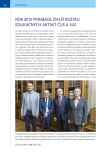ESTABLISHMENT AND CHARACTERIZATION OF MULTIDRUG RESISTANT CELL LINE MODEL OF UROTHELIAL CARCINOMA
Authors:
Michaela Kripnerová 1; Pavel Dvořák 1; Martin Pešta 1; Jitka Kuncová 2; Tomáš Vlas 3; Martin Leba 4; Luboš Holubec 5; Jiří Hatina 1
Authors‘ workplace:
Ústav biologie, Lékařská fakulta UK v Plzni, Plzeň
1; Ústav fyziologie, Lékařská fakulta UK v Plzni, Plzeň
2; Ústav imunologie a alergologie, Fakultní nemocnice Plzeň, Plzeň
3; Katedra kybernetiky, Fakulta aplikovaných věd, Západočeská univerzita v Plzni, Plzeň
4; Onkologická a radioterapeutická klinika, Fakultní nemocnice Plzeň, Plzeň
5
Published in:
Ces Urol 2015; 19(4): 281-290
Category:
Original Articles
Overview
Major statement:
New chemoresistant urothelial bladder cancer cell line as an experimental model for studying the mechanisms of multidrug resistance in advanced bladder cancer.
Aim:
The aim of the study was to establish and characterize a new multidrug resistant urothelial cancer cell line.
Materials and methods:
The parental cancer cell line BC44 was previously established from the large exophytic and better differentiated papillary part of a progressive tumor (pT4 G3) of a female patient. The daughter cell line BC44DoxoR has been derived by prolonged culture in increasing doxorubicin concentrations. Morphological response of parental and daughter cells after application of the individual drugs (doxorubicin, methotrexate, vinblastine, cisplatin, and gemcitabine) has been followed by phase-contrast microscopy. Cell viability has been determined using mitochondrial dehydrogenases assay and quantified by absorption spectrophotometry. Man-Whitney U Test (significance level α = 0.05) has been applied for statistical evaluation.
Results:
The derivative cell line BC44DoxoR exhibited chemoresistance to all cytostatics tested. To the best of our knowledge, this is the first report of such a multidrug resistant urothelial carcinoma cell line.
Conclusion:
The new multidrug resistant urothelial bladder cancer cell line could provide important new insights into understanding the therapeutic resistance of advanced bladder cancer.
KEY WORDS:
Chemotherapy, multidrug resistance, urothelial carcinoma.
Sources
1. Torre LA, Bray F, Siegel RL, et al. Global cancer statistics, 2012. CA Cancer J Clin 2015 Mar; 65(2): 87–108.
2. Montie JE, Clark PE, Eisenberger MA. Bladder cancer. J Natl Compr Canc Netw 2009 Jan; 7(1): 8–39.
3. Dinney CP, McConkey DJ, Millikan RE, et al. Focus on bladder cancer. Cancer Cell 2004 Aug; 6(2): 111–116.
4. Knowles MA, Hurst CD. Molecular biology of bladder cancer: new insights into pathogenesis and clinical diversity. Nature Reviews Cancer 2015; 15 : 25–41.
5. Raghavan MD, Stein JP, Cote D, Jones JS. Bladder Cancer. In: Holland JF, Frei E eds. Cancer Medicine. 8. ed. Shelton: PMPH-USA; 2009 : 1219–1227.
6. Soukup V, Pešl M. Karcinom močového měchýře. Postgraduální medicína 2001; 13(1): 42–47.
7. Dvořáček J, Babjuk M, et al. Onkourologie. 1. vyd., Praha: Galén; 2005.
8. Von der Maase H, Sengelov L, Roberts JT, et al. Long-term survival results of a randomized trial comparing gemcitabine plus cisplatin, with methotrexate, vinblastine, doxorubicin, plus cisplatin in patients with bladder cancer. J Clin Oncol 2005 Jul; 23(21): 4602–4608.
9. Kaya AO, Coskun U, Ozkan M. Paclitaxel plus doxorubicin chemotherapy as second-line therapy in patients with advanced urothelial carcinoma pretreated with platinum plus gemcitabine chemotherapy. Onkologie 2012; 35(10): 576–580
10. Albers P, Park SI, Niegisch G. Randomized phase III trial of 2nd line gemcitabine and paclitaxel chemotherapy in patients with advanced bladder cancer: short-term versus prolonged treatment [German Association of Urological Oncology (AUO) trial AB 20/99]. Ann Oncol 2011 Feb; 22(2): 288–294.
11. Longley DB, Johnston PG. Molecular mechanisms of drug resistance. J Pathol 2005 Jan; 205(2): 275–292.
12. Kripnerová M, Hatina J. Buněčné modely chemorezistence urotheliálního karcinomu. Ces Urol 2015; 19(4).
13. Greife A, Tukova J, Steinhoff C, et al. Establishment and characterization of a bladder cancer cell line with enhanced doxorubicin resistance by mevalonate pathway activation. Tumour Biol 2015 May; 36(5): 3293–3300.
14. Koch A, Hatina J, Rieder H, et al. Discovery of TP53 splice variants in two novel papillary urothelial cancer cell lines. Cell Oncol (Dordr) 2012 Aug; 35(4): 243–257.
15. Seifert HH, Meyer A, Cronauer MV, et al. A new and reliable culture system for superficial low-grade urothelial carcinoma of the bladder. World J Urol 2007 Jun; 25(3): 297–302.
16. Greco O, Powell TM, Marples B, Joiner MC, Scott SD. Gene therapy vectors containing CArG elements from the Egr1 gene are activated by neutron irradiation, cisplatin and doxorubicin. Cancer Gene Ther 2005 Jul; 12(7): 655–62.
17. Bruce ACH, Longo DL. Longo eds. Clinical strategies for cancer treatment: The role of drugs. In: Bruce A. Cancer Chemotherapy and Biotherapy. Principles and Practice. 5th ed. Philadelphia: Wolters Kluwer/Lippincott Williams & Wilkins; 2011, 3–14.
18. Pritchard JR, Lauffenburger DA, Hemann MT. Understanding resistance to combination chemotherapy. Drug Resist Updat 2012 Oct; 15(5–6): 249–257.
19. Moscow JA, Schneider E, Sikic BI, Morrow CS, Cowan KH. Drug resistance and its clinical circumvention. In: Holland JF, Frei E, eds. Cancer Medicine. 8. ed. Shelton: PMPH-USA; 2010 : 597–610.
20. Baguley BC. Multidrug resistance in cancer. In: Baguley BC. Multi-Drug Resistance in Cancer. Methods in Molecular, Biology vol. 596, New York: Humana Press/Springer; 2010, 1–14.
21. Persidis A. Cancer multidrug resistance. Nature Biotechnol 1999 Jan; 17(1): 94–95.
22. O‘Connor R. The pharmacology of cancer resistance. Anticancer Res 2007 May-Jun; 27(3A): 1267–1272.
23. Mohelníková-Duchoňová B, Souček P. Role membránových transportérů v chemorezistenci karcinomu pankreatu při terapii gemcitabinem. Klin Onkol 2010; 23(5): 306–310.
24. Drayton RM, Catto JW. Molecular mechanisms of cisplatin resistance in bladder cancer. Expert Rev Anticancer Ther 2012 Feb; 12(2): 271–281.
Labels
Paediatric urologist Nephrology UrologyArticle was published in
Czech Urology

2015 Issue 4
Most read in this issue
- SEVEN YEARS EXPERIENCES WITH APLICATION OF SHOCK WAVES TO MEN WITH PEYRONIE‘S DISEASE
- SYNCHRONOUS BILATERAL TESTICULAR SEMINOMA
- INFECTED CYST CAUSING A MECHANICAL SYNDROME AS A COMPLICATION OF A RENAL CELL CARCINOMA
- TREATMENT OF LOCALIZED AND LOCALLY ADVANCED PROSTATE CANCER FROM A UROLOGIST‘S AND RADIATION ONCOLOGIST’S POINT OF VIEW.
